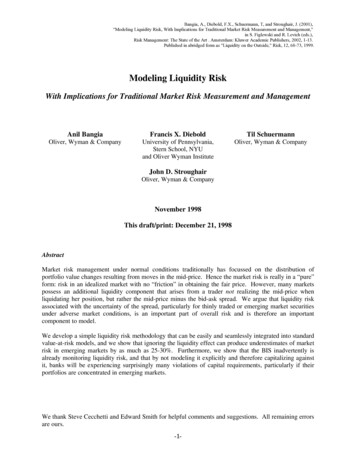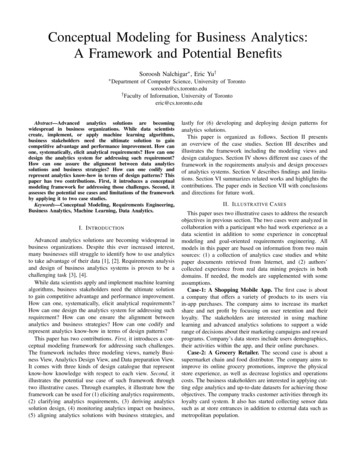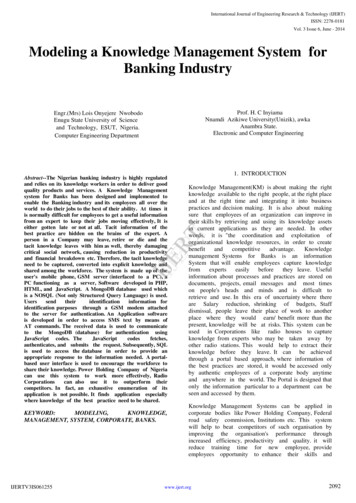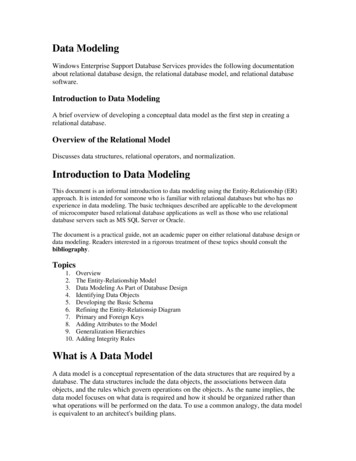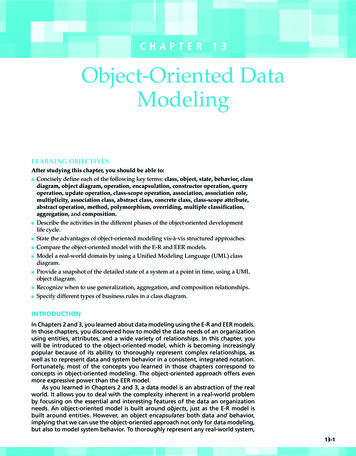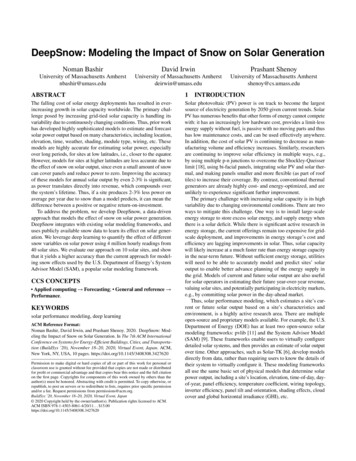
Transcription
DeepSnow: Modeling the Impact of Snow on Solar GenerationNoman BashirDavid IrwinPrashant ShenoyUniversity of Massachusetts Amherstnbashir@umass.eduUniversity of Massachusetts Amherstdeirwin@umass.eduUniversity of Massachusetts Amherstshenoy@cs.umass.eduABSTRACT1The falling cost of solar energy deployments has resulted in everincreasing growth in solar capacity worldwide. The primary challenge posed by increasing grid-tied solar capacity is handling itsvariability due to continuously changing conditions. Thus, prior workhas developed highly sophisticated models to estimate and forecastsolar power output based on many characteristics, including location,elevation, time, weather, shading, module type, wiring, etc. Thesemodels are highly accurate for estimating solar power, especiallyover long periods, for sites at low latitudes, i.e., closer to the equator.However, models for sites at higher latitudes are less accurate due tothe effect of snow on solar output, since even a small amount of snowcan cover panels and reduce power to zero. Improving the accuracyof these models for annual solar output by even 2-3% is significant,as power translates directly into revenue, which compounds overthe system’s lifetime. Thus, if a site produces 2-3% less power onaverage per year due to snow than a model predicts, it can mean thedifference between a positive or negative return-on-investment.To address the problem, we develop DeepSnow, a data-drivenapproach that models the effect of snow on solar power generation.DeepSnow integrates with existing solar modeling frameworks, anduses publicly available snow data to learn its effect on solar generation. We leverage deep learning to quantify the effect of differentsnow variables on solar power using 4 million hourly readings from40 solar sites. We evaluate our approach on 10 solar sites, and showthat it yields a higher accuracy than the current approach for modeling snow effects used by the U.S. Department of Energy’s SystemAdvisor Model (SAM), a popular solar modeling framework.Solar photovoltaic (PV) power is on track to become the largestsource of electricity generation by 2050 given current trends. SolarPV has numerous benefits that other forms of energy cannot competewith: it has an increasingly low hardware cost, provides a limit-lessenergy supply without fuel, is passive with no moving parts and thushas low maintenance costs, and can be used effectively anywhere.In addition, the cost of solar PV is continuing to decrease as manufacturing volume and efficiency increases. Similarly, researchersare continuing to improve solar efficiency in multiple ways, e.g.,by using multiple p-n junctions to overcome the Shockley-Queisserlimit [18], using bi-facial panels, integrating solar PV and solar thermal, and making panels smaller and more flexible (as part of rooftiles) to increase their coverage. By contrast, conventional thermalgenerators are already highly cost- and energy-optimized, and areunlikely to experience significant further improvement.The primary challenge with increasing solar capacity is its highvariability due to changing environmental conditions. There are twoways to mitigate this challenge. One way is to install large-scaleenergy storage to store excess solar energy, and supply energy whenthere is a solar deficit. While there is significant active research inenergy storage, the current offerings remain too expensive for gridscale deployment, and improvements in energy storage’s cost andefficiency are lagging improvements in solar. Thus, solar capacitywill likely increase at a much faster rate than energy storage capacityin the near-term future. Without sufficient energy storage, utilitieswill need to be able to accurately model and predict sites’ solaroutput to enable better advance planning of the energy supply inthe grid. Models of current and future solar output are also usefulfor solar operators in estimating their future year-over-year revenue,valuing solar sites, and potentially participating in electricity markets,e.g., by committing solar power in the day-ahead market.Thus, solar performance modeling, which estimates a site’s current or future solar output based on a site’s characteristics andenvironment, is a highly active research area. There are multipleopen-source and proprietary models available. For example, the U.S.Department of Energy (DOE) has at least two open-source solarmodeling frameworks: pvlib [11] and the System Advisor Model(SAM) [9]. These frameworks enable users to virtually configuredetailed solar systems, and then provides an estimate of solar outputover time. Other approaches, such as Solar-TK [6], develop modelsdirectly from data, rather than requiring users to know the details oftheir system to virtually configure it. These modeling frameworksall use the same basic set of physical models that determine solarpower output, including a site’s location, elevation, time-of-day, dayof-year, panel efficiency, temperature coefficient, wiring topology,inverter efficiency, panel tilt and orientation, shading effects, cloudcover and global horizontal irradiance (GHI), etc.CCS CONCEPTS Applied computing Forecasting; General and reference Performance.KEYWORDSsolar performance modeling, deep learningACM Reference Format:Noman Bashir, David Irwin, and Prashant Shenoy. 2020. DeepSnow: Modeling the Impact of Snow on Solar Generation. In The 7th ACM InternationalConference on Systems for Energy-Efficient Buildings, Cities, and Transportation (BuildSys ’20), November 18–20, 2020, Virtual Event, Japan. ACM,New York, NY, USA, 10 pages. https://doi.org/10.1145/3408308.3427620Permission to make digital or hard copies of all or part of this work for personal orclassroom use is granted without fee provided that copies are not made or distributedfor profit or commercial advantage and that copies bear this notice and the full citationon the first page. Copyrights for components of this work owned by others than theauthor(s) must be honored. Abstracting with credit is permitted. To copy otherwise, orrepublish, to post on servers or to redistribute to lists, requires prior specific permissionand/or a fee. Request permissions from permissions@acm.org.BuildSys ’20, November 18–20, 2020, Virtual Event, Japan 2020 Copyright held by the owner/author(s). Publication rights licensed to ACM.ACM ISBN 978-1-4503-8061-4/20/11. . . UCTION
BuildSys ’20, November 18–20, 2020, Virtual Event, JapanThe modeling frameworks above are generally highly accurateafter configuring or calibrating them for a particular solar site. Unfortunately, this accuracy significantly degrades for sites at higherlatitudes due to the effect of snow on solar output. While snow effects only occur during winter, they are large enough to degrade theaccuracy of yearly estimates of solar output. Even a small amountof snow (less than 1 inch) can completely cover panels, and reducepower output to zero for extended periods of time. Solar output athigher latitudes in winter months tends to also be highly volatile, andalmost completely based on snowfall. For example, at one site wemonitor in the Northeast U.S., we recorded a monthly solar outputin March, 2018 of 256kWh, and in March, 2019 of 774 kWh. The302% increase in monthly solar output was due almost exclusively tosnow cover, with 2018 having much more snow in March than 2019.This snowfall had a significant impact on the annual solar output aswell. For the same site, the 2018 annual output was 8,141kWh, whilethe 2019 annual output was 9,091kWh, or a difference of 950kWh.Importantly, at this site, the difference in solar output in the wintermonths (January, February, March) in 2018 and 2019 accounted for617kWh (or 65%) of the difference in output over the year, eventhough the winter months only accounted for 8% (2018) and 14%(2019) of the yearly output. Thus, for high latitude solar sites, thevariability in solar output is disproportionately affected by snowfallin the winter. As a result, accurately modeling the effect of snowfallis important both at short-term intervals, e.g., every hour, and overlong-term intervals, e.g., over months and years. At short-term intervals as snow melts, solar output is determined by the rate of snowmelt as well physical features, such as a panel’s tilt angle. As our example shows, accurately modeling snow over long-term intervals isalso important: improving accuracy by even a small amount (2-3%)can be significant, since power translates to monetary revenue, whichcompounds over time. Thus, a 2-3% difference when compoundedover a 25-year lifetime is significant and can make the differencebetween a positive and negative return-on-investment (ROI).To address the problem, we develop DeepSnow, a data-drivenapproach to modeling snow effects on solar power. Our hypothesisis that DeepSnow can significantly improve the accuracy of existingsolar modeling frameworks for higher latitudes with snowfall. Inevaluating our hypothesis, we make the following contributions.Snow Data Analysis. We analyze public snow data to learn the snowvariables that most affect solar generation. Snow is highly complex,and public snow data sites record over 40 different variables thatdescribe snow. We analyze this dataset and identify the variablesthat most correlate with solar output. In total, our analysis covers 4million hourly snow readings from 40 solar sites.Deep Learning Approach. We combine the snow data with otherdata, such as the shading level, tilt angle, and temperature, to learnthe effect of snow on solar output. Our approach builds on other solarmodeling frameworks by augmenting them to account for the effectof snow. When snow is not present, our approach simply devolves tothe current state-of-the-art. Thus, our model distills only the effectsof snow on solar output and does not conflate it with the effect ofother variables. We learn a common model for snow that can beapplied to any new or existing solar site without re-training.N. Bashir, et al.Implementation and Evaluation. We integrate our approach intoan existing solar modeling framework [6], and evaluate its performance on 10 solar sites. We compare it to the same modeling framework without considering snow, and to DOE’s SAM model, whichincludes a physical snow model. We show that our approach significantly outperforms the SAM model, consistently yielding betteraccuracy across all 10 sites by up to 7% over a year, and much moreover the winter months and at shorter time intervals. We also showthat DeepSnow is more accurate than SAM even over the summer.2BACKGROUNDWe briefly summarize the impact of snow on solar power and discussphysical models that describe the relationship between differentsnow properties and solar power.2.1Solar Performance ModelsThere has been significant prior work on solar performance modelingand forecasting. Solar performance modeling infers a site’s solarpower output at the current time based on known conditions, whilesolar forecasting predicts a site’s solar output at a future time basedon forecasted conditions. While there has been hundreds of paperson this topic, there are a limited number of toolkits using thesemodels that are open-source and available for public use. Below, wedescribe the three most prominent solar performance modeling tools.While we discuss these approaches, our main focus is on describinghow these toolkits incorporate snow effects on solar panel output.System Advisor Model (SAM). The System Advisor Model (SAM)is a financial and performance model that estimates the cost of energyfor grid-connected power projects [7]. SAM contains performancemodels for a variety of energy resources and their relevant financialmodels, but we focus only the performance model for photovoltaic(PV) systems. SAM’s performance model requires users to provide detailed information about the site, i.e., type of PV moduleused, wiring of panels, inverter model, site’s tilt, and orientation.Researchers may not have access to such detailed information whenperforming analyses on a large number of solar sites. In addition,SAM takes the weather data in the Typical Meteorological Year(TMY) format and provides support to download TMY weather filesfor locations across the United States. However, if users must evaluate the performance of a site for a given year, they must go through anon-trivial process of constructing TMY files for the desired locationand year. Therefore, SAM is more suited for a one-time feasibilityanalysis of a PV site. Despite SAM’s configuration challenges, itprovides a good baseline for our analysis, as we expect DeepSnowto be used for energy estimates of solar sites similar to SAM.An attractive feature of SAM’s performance model is that it takesinto account the energy loss due to snow. The snow model usedby SAM is based on prior work that calculates the percentage of aPV array that will be covered by snow given the daily snow depthmeasurement, plane of array irradiance, temperature, and the tiltangle for the site [13]. This model considers the snow sliding offthe surface of solar panels as the dominant snow removal process.However, the model does not take into account snow melting due totemperature, or the wind blowing light snow from the panel surface.SAM’s snow model uses daily snow depth values. At the beginningof the day, the model will check if there is a snow event, and, if thesnow depth is greater than 0, the model assumes that all solar panels
DeepSnow: Modeling the Impact of Snow on Solar Generationon the site are covered by the snow. At each hour, the model willthen check if the following condition is met.IpoamHere, Ta is the ambient temperature, Ipoa is the plane of arrayirradiance, and m is an empirically determined constant with a valueof -80 mW2 C . This inequality checks if the ambient temperature andplane of array irradiance are high enough to allow some of the snowto slide off the array surface. If the given inequality is satisfied fora particular hour, some portion of the PV array will be exposedto direct sunlight. The amount of exposed surface is intuitivelydependent upon the tilt angle for the site and is computed as follows.Snow Slide Amount 1.97 sin(tilt)Ta Here, 1.97 is the sliding coefficient determined empirically by theauthors of the snow model [13]. The Snow Slide Amount computedfrom the previous equation is given as multiple of 1/10th of thearray’s height. For example, a value of 2 for the Snow Slide Amountmeans that 2/10th of the array is exposed to sunlight. Note that themodel assumes that the snow completely slides off the panels anddoes not accumulate near the bottom of the panel. If the snow slidesoff in a given hour, the model determines the fraction of solar panelsexposed at the end of the hour. Solar output for a correspondingnumber of panels is set to normal, while the covered panels’ output isset to 0. The model makes a few simplistic assumptions, such as snowremoval occurring only because of sliding, and snow completelysliding off the panels and not accumulating near the bottom, and thepower output of the covered portion of the panels being 0. As weshow, these assumptions significantly reduce the accuracy of thissnow model compared to DeepSnow, which implicitly models thesephenomenon by learning them from data.PVlib. PVlib is a python library for modeling solar energy systemsthat, compared to SAM, focuses more on programmability and lesson financial estimates [11]. PVlib’s model library implements multiple physical models for various factors related to solar performance,i.e., pvlib has multiple models for solar irradiance to power conversion. The underlying models used by SAM are also available inPVlib. Like SAM, PVlib also requires the user to specify detailedinformation about a solar site to model it. PVlib uses the same snowmodel as SAM. Due to these overlapping characteristics, we do notconsider PVlib for further analysis in this paper.Solar-TK. Solar-TK is a black-box solar performance model thatis open-source and publicly available [6]. This model calibratesthe model parameters entirely from a small amount of historicalgeneration data from a solar site. Once calibrated, the model onlyrequires as input a site’s location, time, and weather (cloud coverand temperature) over some time resolution, and returns as outputan estimate of solar energy over that time resolution. Solar-TK alsohas an optional shade-adjustment module that uses machine learning(ML) to learn the effect of shading from nearby buildings and treeson solar output. The shade-adjustment module provides its outputas a fraction between 0 and 1: a value of 0 indicates that power hasdropped to zero because of shade and a value of 1 indicates thatshading has no effect on the site. Such shading has an effect on snowmelting, as shaded snow melts slower than the non-shaded snow.Therefore, we use the shade factor provided by Solar-TK as oneof the features of DeepSnow’s model. However, Solar-TK does notBuildSys ’20, November 18–20, 2020, Virtual Event, Japanmodel the effect of snow on solar power output. Since Solar-TKis modular and extensible, we integrate a DeepSnow module thataugments Solar-TK’s existing framework to model snow.2.2Solar Performance Modeling under SnowThe key effect of snow on the solar sites is in the form of blockingthe solar irradiation from reaching the panel surface. The importanceof this can be assessed and even quantified by utilizing the physicalmodels for the optical properties of snow. There are a large number offactors that affect these optical properties, such as the average snowflake/grain size, free water content, or the formation and density ofthe layers within the snowpack [10].The most important property of the snow is its reflectance, whichis also often called its albedo, that describes the ratio of reflectedradiation from a surface to radiation incident on it. The albedodepends upon the snow depth for the thin snow layers, and priorwork has shown that it will reach its maximum value when thesnow depth is around 4cm [14]. The reflectance is not the onlyphenomenon that reduces the solar irradiation reaching the panelsurface, as snow absorbs some of the radiation as well. However,the absorption effect is less significant when compared with thereflectance. As the snow melts, the transmission of solar irradiationto the surface may not increase as the increased snow water contentincreases the absorption of radiation in the snow water [17]. Whilethere is a consensus that the combined effect of reflectance andabsorption means that even a small amount of snow will greatlyreduce the solar generation, the depth of snow needed to block 99%of light varies from 2-74cm in prior work [12, 17].Researchers have established that the snow depth along with snowwater is not enough to describe the effect of snow on solar irradiation.The top layer of snow has different optical properties than the snowin the deeper layers of the snowpack, which are compressed bythe weight of upper snow layers. At snow depths lower than thethickness of the top layer, the optical properties of the snow packwill be influenced by its underlying surface. This top layer has ahigher extinction coefficient than the deeper snow, resulting in amore rapid extinction of solar radiation passing through it [12, 14].Further, the extinction coefficient of a typical snowpack, within thevisible spectrum, varies across different wavelengths of radiation. Atlonger wavelengths, the solar radiation penetrating the snow layer isof a comparatively low wavelengths with the highest transmittanceoccurring at wavelengths between 450 and 550nm. The extinctioncoefficient of snow appears to be the lowest between 400 and 700nm,increasing sharply for wavelengths above 700nm. The extinctioncoefficient is somewhat lower for older snow than for new fluffysnow, and significantly higher for very wet, melting snow [14, 17].The primary point o
describe the three most prominent solar performance modeling tools. While we discuss these approaches, our main focus is on describing how these toolkits incorporate snow effects on solar panel output. SystemAdvisorModel(SAM).The System Advisor Model (SAM) is a financial and performance



